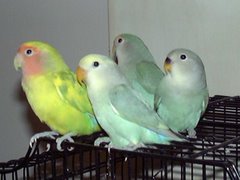Lillian’s Love Bird Parrot-an Overview
 Lillian’s love birds are famous African love bird species. These are the smallest parrots species found in the African mainland. These birds are only 5 inch long. The one odd thing about this breed is that these birds are very difficult to breed.
Lillian’s love birds are famous African love bird species. These are the smallest parrots species found in the African mainland. These birds are only 5 inch long. The one odd thing about this breed is that these birds are very difficult to breed.
Lillian’s love birds are available in very small population and are very much unnoticed and unrecognized. These birds are generally mistaken as Fischer lovebirds. The confusion is because Fischer lovebirds too are very small but are marginally bigger in size than Lillian’s love birds. At times the Lillian’s lovers are also confused with peach-faced lovebirds. Though both resemble in their appearance peach –faced love birds don’t have white eye rings of the Lillian’s love birds but have clear orange tone which is absent in peach-faced love birds.
Lillian’s love birds head is orange in colour and the same trails down towards the upper chest and neck. The orange tone fades to yellow around the abdomen and upper chest. The wings and the lower bodies are light green in colour. The outer wing of the bird appears darker when compared to the belly portion of the bird.
The Lillian’s love birds love to feed on millet, grass seeds, flowers, fruits, wild rice etc. the breeding season for the love birds begins in January and ends in March first half. There is second breeding season which start in June and ends in July. During these seasons these birds make nest in the fissures of the tree and the nests are roofed. If domesticated, these love birds yield three to eight white coloured eggs. The incubation period is 22 days. The birds leave the nest after 44 days.
Lillian’s love birds are noticed very commonly around Zimbabwe, Malawi, Mozambique, Zambia, and Tanzania. As per the study conducted and charted in the year 2004, the love bird’s population was very much reduced and was report less than twenty thousand birds only. These lovely love birds were already classified as ‘near threatened ‘.
These love birds at present inhabit Liwonde national park and are preserved well there. The authorities and the decision makers of the park are very firm in their decision of not distributing these birds to the outside as the breeding and the feeding grounds are very much exploited by the urbanization and agricultural practices.
In addition to this these love birds die in large numbers due to the poisoning. The poisoning cases are steadily on the rise which is really a cause of concern. No body could really explain why these little creatures are being poisoned. But the consensus is that these love birds could have become accidental victim. The poachers must be using some chemicals for the reason best known to them only. These love birds must have consumed those poisonous fruits, seeds, etc thus getting in to the trouble.
The Liwonde national park authorities are taking very much extra care for the very survival of these lovely looking creatures as they are considered one of the wonders of the Mother Nature. Let’s hope their service to this Lillian’s love birds continues for ever.







 Free Ads For Bloggers
Free Ads For Bloggers


No comments:
Post a Comment